
High end luxury cars are still cars. They get you from point A to point B. Unless they don’t. Rolls Royce used to call the problem “failure to proceed.” Never mind. Their owners don’t. They accept a certain level of mechanical “quirkiness” in exchange for beauty and bragging rights. Top end firearms makers don’t have that luxury. They can’t put rarity or comfort ahead of reliability. While you and I might consider a Smith & Wesson 500 a novelty, plenty of owners use—and yes depend on—the weapon. Wilson Combat “gets it.” The legendary gunmaker makes its living by combining battlefield-strength reliability with high end luxury. Call it functional luxury. Or X-TAC.
Design
The X-TAC has a multiple personality disorder—and I mean that in a good way. On one hand, it’s a work of art. The 1911-style pistol’s silky smooth Mil-spec Parkerized finish and uniquely patterned frontstrap and slide treatment are way too sexy for its shirt. The weapon’s classic proportions are exactly as God and John Browning (same thing?) intended. You don’t have to obsess about the X-TAC almost microscopic attention to detail to see that the gun is a thing of beauty. But you can if you want to.
On the other hand, the handgun is more than slightly “intimidating.” And again, I mean that in a good way. The Wilson’s big bad beavertail, X-marks-the-spot graphic (on the side of the barrel) and exclusive black-on-black, rope-like G-10 Starburst grip panels create an overall air of malevolence. This doesn’t need to be said, but I’ll say it: if you were looking at this X-TAC from the muzzle-side, that vast, gaping hole in front would make you think twice about doing something aggressive.
Love at First Sight?
The first thing you notice when shooting the X-TAC: the sights. More specifically, the rear sight. Imagine a square crossed with a trapezoid with six-sides. An asymmetrical hexagon if you will. The .145” wide U-Notch is designed for “optimum sighting in low-light, dynamic range conditions.” Most sights—combat or target style—are square shaped with sharp edges, and have an equally square sight notch. Wilson says this new “Battlesight” (combined with their fiber optic front sight) provides a “crisp, protected sight picture.”
Eventually. Initially, the sights don’t naturally “fall” into place like other sets. For proper alignment, you have to align the top of the front sight with the top of the rear sight. Sound simple enough right? Like others fortunate enough to get some hands-on experience the X-TAC, I found myself aligning the fiber-optic tube with the bottom of the rear sights “U”, causing most shots to go low. Of the six people who shot the pistol, five of them grouped low. Only one person naturally found the correct sight picture.
Even after putting 1000 rounds of ammo through the Wilson X-TAC, I still had to pause and think about the sight picture each and every time. Perhaps with another 3000 rounds, aligning the sights will become instinctual. I’d prefer Wilson’s standard sight set or a set of their optional tritium sights. At the bare minimum, a set of fiber-optic fibers in the rear sight would help get the front sight naturally aligned with the rear.
Aw Shoot
Aside from the difficult-to-align sights, in fact even WITH the difficult to align sights, the X-TAC is to shooting what a Rolls Royce Phantom Coupe is the Cote D’Azur: class, style and elegance. The Wilson holds well, points well, shoots well and does everything it is supposed to do with subconscious (for the shooter) ease.
Truth to tell, I never wanted to stop shooting the X-TAC. On my first trip to the range, I blew through a full 250 round bulk-box of 230-gr FMJ ammo, and two boxes of Winchester PDX-1 Personal Protection Ammo. To extend my range session, I went back into my range bag and pulled out a 100-round pack of Winchester WWB 230-gr FMJ ammo.
Compared to an all-stainless steel 1911, the all carbon steel X-TAC’s recoil feels more like an explosion than a kick; like tying a firecracker to the end of a stick and lighting the fuse. To help tame the effect, the X-TAC’s G10 Starburst grips are designed to “lock” into your hands under recoil. The X-TAC never seemed to “settle in” under recoil; I found myself re-gripping the pistol half-way through a string. To be fair, other shooters had no such issues.
Trigger, Control
Unlike the bullets coming out of the business end of the X-TAC, the gun’s Starburst grips are strictly hit or miss. While I was comfortable with the front and back strap checkering, the side panels never gave me the secure purchase I enjoy with a more traditional setup. RF suggested shooting the X-TAC with gloves to see if the design helps in cold conditions. The results were inconclusive. But my hand thanked me.
No question about the trigger though. The X-TAC’s crisp 3-1/2 lbs. pull is the only thing [barely] stopping you from sending a mess of lead down range. The trigger’s sharp and clean and breaks like uncooked spaghetti. It’s also as light as helium balloon in a space station. Three of our guest shooters had accidental “double shots.” On no account should a new-to-1911s owner holster the X-TAC for self-defense without some serious trigger time.
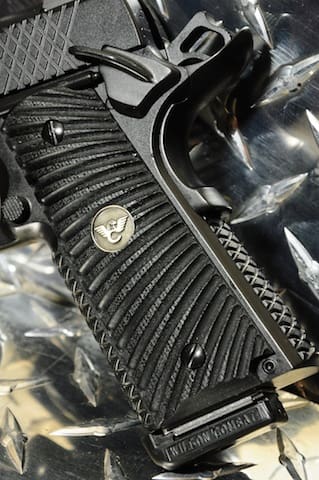
Safety First
As the only 1911 shooter in my group of testers, I thought I’d be the only one to notice that the X-TAC’s safety locked into place with extra-firm precision. My guest shooters mentioned it unbidden, as did many of the poor unfortunate souls who handled the X-TAC without shooting it.
Accuracy
I didn’t bother to do an accuracy test on the X-TAC. No need. Wilson guarantee’s 1” accuracy at 25-yards. Plain and simple, this gun is guaranteed to outshoot anyone pulling the trigger. While many of us grouped low on average, the groups were tight and consistent at anything remotely resembling combat range. No “wild fliers.” None. The X-TAC is what 1911 accuracy is all about. No wonder RF qualified for his RI concealed carry permit with this pistol.
Reliability
Wilson Combat makes some of the world’s finest weapons. Their guns have a well-earned, well-deserved reputation for working all the time, every time. After field stripping the X-TAC a dozen times, I can attest to the excellence of the pistol’s parts and assembly. A properly maintained X-TAC will become a cherished family heirloom, protecting generations to come.
In the field, where it counts, I never experienced a single FTF (Failure to Feed) or FTE (Failure to Eject) with any type of ammunition. More importantly for a single-stack 1911, I never had a single FTL (Failure to Load).
For 1911’s, this can be a difficult task. The “controlled feed” method of cartridge delivery is extremely effective with ball-ammo. But JHP rounds can give these Browning-designed firearms trouble. The open and sometimes very angular nature of JHP bullets can jam into the feed-ramp, essentially locking up the firearm.
This can be especially troubling if the extractor doesn’t gain enough speed to snap onto the rim of the cartridge. The standard tap-rack-bang approach to clearing a jam won’t work. You have to rack the slide, tip the pistol to the side (to clear the mis-loaded cartridge) and release the slide – if you’re lucky. Often, the hollow-point jams into the feed point so much that you’ll need to lock the slide back, eject the magazine, use your finger to remove the offending cartridge and proceed to reload the pistol.
I mention all this because Wilson pistols’ tight-fitting clearances worry some people. While I certainly agree that too-tight clearances can lead to problems in extremely dusty environments, the X-TAC’s supposed delicacy is a complete non-issue. Most of the people purchasing an X-TAC will carry this pistol right here in the good ol’ U.S. of A. No 15-story dust storms with sub-micron silica particles will challenge your Wilson’s reliability.
Carry On My Wayward Wilson
Thanks to their narrow grips, 1911’s make for excellent concealed carry weapons. The XTAC is no exception. In fact, it’s exceptional. The X-TAC’s sleek, single-stack frame hardly ever prints, even with a tucked-in shirt. Although the X-TAC’s not a “lightweight” pistol in any sense of the word, you’d be forgiven for thinking so. Nestled into a CrossBreed SuperTuck holster, the 46 oz. fully-loaded Wilson just seemed to disappear.
The X-TAC’s Battlesight certainly helps make it easy to carry. Unlike some square-bladed sights, Wilson’s rear sight’s distinctive shape doesn’t dig into you when carrying, nor does it catch clothing upon holstering or drawing. Wilson also de-horns the gun, just for fun.
Conclusion
Although the grip panels are a bit brash for my tastes, the Wilson Combat X-TAC is a deeply sexy 1911. I’m not a big fan of Wilson’s new Battlesights; but that’s a personal opinion that could change over time. Buyers at this level can afford to give them a go, and then swap them out if they experience similar results. This is highly recommended if you plan on switching between carry guns with more traditional sights.
If you get the feeling that I’m making excuses for the X-TAC’s shortcomings, you’re right. The X-TAC’s X-factor makes caviling seem churlish. In other words, the X-TAC has that special something you get from a beautifully made high end gun. A feeling of solidity and strength that gives owners confidence in their ability to hit what they’re aiming at when it counts. The WIlson Combat X-TAC is a work of art that works.
Specifications
Caliber: .45 ACP
Magazine Capacity: 8 Round
Barrel Length: 5″
Overall Length: 8.7″
Sight Radius: 6.6″
Height: 5.6″
Width: 1.3″
Weight Empty: 38.1 oz.
Weight Loaded: 46.2 oz.
Accuracy Guarantee: 1″ At 25 yds.
Base Model: Starting at $2,395.00
RATINGS (Out of Five):
Style * * * *
Very “Special Ops” and modern looking for a gun almost 100 years old. Starburst panels don’t do it for me, but they might for you.
Ergonomics (carry) * * * *
Lighter than a stainless steel version, but still no lightweight. No sharp edges and a nicely sized and shaped safety.
Ergonomics (firing) * * * *
Extremely crisp trigger. Rated at 3-1/2#s but more like 2-1/2#. Recoil is similar to other 1911 pistols of the same size and weight.
Reliability * * * * *
This is where Wilson Combat shines. No failures noted.
Overall Rating * * * * *
Functional luxury at its finest.

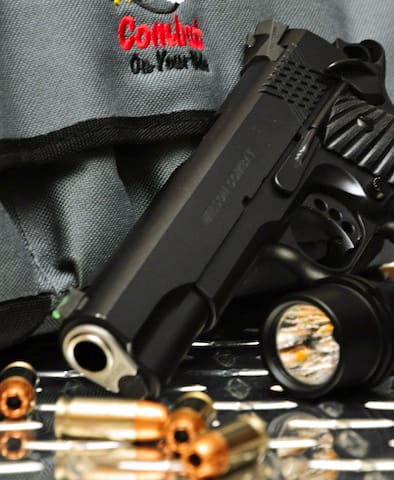
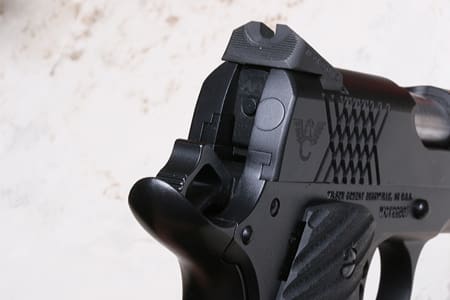
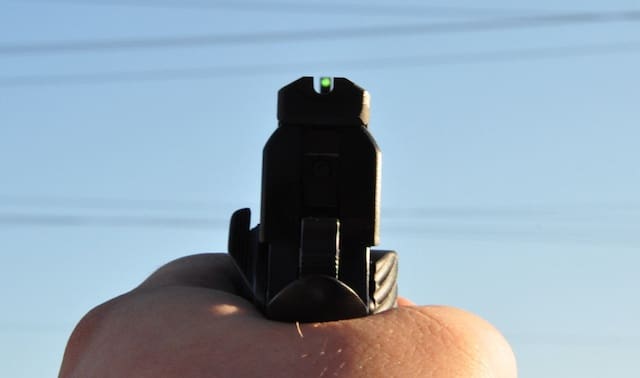

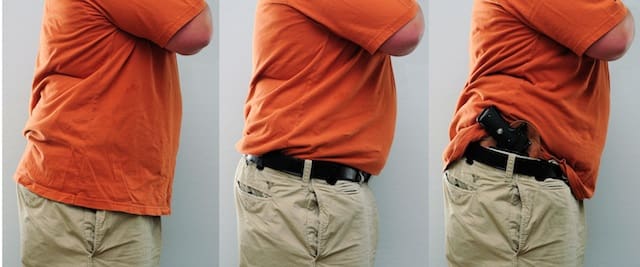
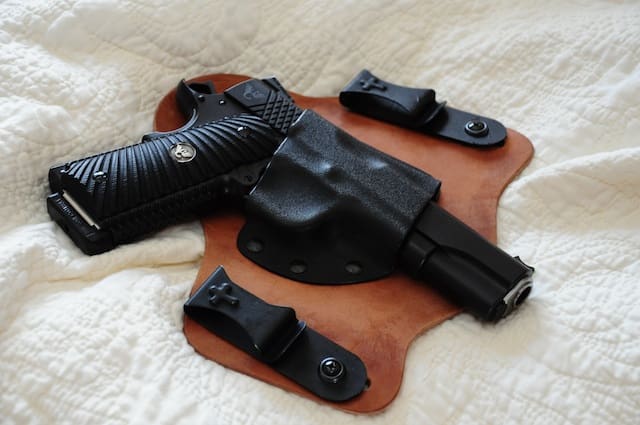



Excellent review, and very fair. Your comments about the sights are well taken. A wider selection of sight options in general is something I've heard WC is addressing. It is the single most asked for item among WC owners in a recent online inquiry. I read another review where the trigger pull was addressed as being on the light side. An actual measurement with a scale might better answer that question since Wilson is said to never send a stock pistol out with a trigger pull of less than 3.5 lbs. Of course this won't mitigate real life "feel", especially for those used to shooting XDs, HKs, etc. Finally, you didn't mention your opinion on the "look" of the XXX engravings on the slide and frame. Some hardcore, old schoolers don't like it, but WC says it's more aggressive than their 30lpi checkering. Personally I think it's a nice option, if it works. Thanks for a great review!!
Kevin
Also, I know your an experienced gun handler, but PLEASE be careful what you show in videos. In your disassembly video you wave your hand after racking the slide with a magazine inserted. OUCH! Only after that do you clear the gun.
I understand the concern. Rest assured that the Wilson was cleared and chamber-empty at least 2 times before filming the disassembly process. Once when it came out of the case and brought into the garage, and once again before I hit the "record" buttom. Point noted however.
How are you shooting low? You align the top of the front sight with the top of the rear sight. That is sight alignment. you don't line up sights by using dots, dashes or other nonsense.
The fiber is just to find the sight at close range under stress or low light. Jeez.
Rex – I am aware on how to align sights, thanks. Also, fiber optic sights are not designed for close range as you say. Ask any IDPA or USPSA shooter about how many times they use their front fiber optic sight on shots under 5 yards and I can guarantee that all of them will reply "never". The 1911 I use for single-stack has a square notch in the rear and a Dawson FO front sight and I have never had any issues aligning the sights. Actually, I moved up 2 classes with this 1911, so I'd say I have the sight-alignment thing figured out.
I mentioned the sights because I consistently shot low each and every time I shot from unholstering or under a quick target transition. The "U" shape combined with the round fiber optic front sight doesn't naturally align under speed. As you said "just align the top of the front sight with the top of the rear". Well, when speed matters your brain reacts differently. On a square notch/square blade set of sights, alignment is natural (square and square). With the Battlesight/FO set, all you see if this big, bright green dot. Your mind, since it is seeing a circle, naturally wants to align it with a circle. Instinctually, you align the green circle with the circle at the bottom of the rear sight. This is the same principle behind ghost-ring sights. You don't need to think about aligning the front sight with the ghosted ring, your brain naturally aligns them. This is why they are so effective. Thanks for the criticism; hopefully this cleared it up some for those that may have been confused.
I think you are incorrect on many counts. First, stainless steel is no heavier than carbon steel.
Second, if you are looking at the rear sight you are looking at the wrong thing. As a Master shooter in several disciplines (IDPA, IPSC) you look THROUGH the rear sight. You align the top of the front with the top of the rear. That is how you ensure correct sight alignment.
http://www.10-8performance.com/Sights_Home.html
http://www.warrentactical.com/products.htm
Here are some U-notch used by serious shooters, tactical and competitive.
If you shot low with ANY sight, it means you didn't call your shot.
Just so no one is confused by Rex, Stainless steel is absolutely more dense than carbon steel. By approximately .2 g/ cm^3
How exactly do you explain you comment that the carbon steel Wilson recoils differently than some stainless steel 1911 that you have shot before? The Wilson feels like an explosion? I've shot a few Wilson's, and have never felt one that felt like it was a "firecracker in my hand"? Do you have much experience with 1911's?
Hello Bill – I shoot a 1911 in Limited-10 and SS divisions. I tear them apart all the time, fit my own parts, and fix pistols that others have screwed up themselves. This year so far, I probably shot a dozen unique 1911 pistols. Am I a 1911 expert? Well I don't know what that criteria would be, so let’s consider me "well versed in the arts".
I would say the differences between a carbon-steel 1911 vs. a stainless 1911 would be the same as the difference in shooting a S&W 36 and then shooting a S&W 60. Stainless is heavier (obviously), but I do not think that this is really what changes the "feel" of the gun. The weight change changes the balance of the pistol, enough so that it is very noticeable when shooting them. The Wilson 1911 is no different. Are stainless 1911’s (or any gun) balanced better? Not likely, but they feel better to me. Most would agree that stainless guns feel different than carbon steel pistols. How much so depends on the shooter. Your mileage may vary.
Nice review. I would love to own one but will have to make due with my Springfield for a while longer. I also enjoy the crossbreed holster although I did have a custom made buckles belt that uses the fully hidden velcro clips so I don't have any visible clips. The main reason for the belt is I work around Harley's and would hate to scratch one.
Excellent review, thanks for posting this.
Wilson Combat Question Of The Day: How Do YOU Pronounce X-TAC, "Eks-tak" or "Ecstacy"?
Being a Wilson, either one would be appropriate! I think (and assumed) that it's pronounced "X-TAC" like "Ex-Tack"…. or like eXtreme-TACtical.
I shoot 1911’s often (no expert) just a fan. I have yet to shoot a Wilson but do own several Ed Brown’s and love them. At this level and price point, expectations should be exceeded. I enjoyed the review and the child like banter between some. I believe productive should exclude trying to one up instead enjoy the fact that we enjoy the shooting sport and be helpful.
Patrick, you put a great deal of thought and time into your review. I thank you, but for the life of me I don’t understand your video clip at the range and your stated rounds shot. What possible benefit did you get out of shooting over 400 rounds of .45 cal ammo in one session…Especially the 48 rounds you shot in the video. Shooting that fast with no clue of where you were shooting, except to say, you and your friend held what looked to be a three to four “FOOT” group. Your comment “the groups were tight and consistent at anything remotely resembling combat range. No “wild fliers”. You’re kidding right??? You shot at least $200.00 worth of ammo. Wow! Maybe you have the money and you like to hear the gun go bang but in my humble opinion I think you would do better shooting 75 to 100 rounds (per session) working on specific drills. Just a thought.
I’ve owned a Bill Wilson Carry for a little over a year. Concerning recoil (4″ barrel) I’ve never shot a 4″ (and very few full sized) 1911 pistols that had better balance or more managable recoil. And I’ve shot my share of 1911’s including Baer, Brown and the gun made by the boys that left Wilson Combat…Of which, few people seem to know those fine pistolsmiths are no longer with Nighthawk.
My problem is age…With over 50 years of shooting my eyes are not as good as they once were. I have my pistol back with Wilson Combat right now being fitted with the green fiber optic front sight and the same rear sight u-notch on your X-TAC. I’ve read quite a few reviews and have not heard any complaints from others having the problem you have had with the sights. Iask you now, do you think I will like the sights or not? Have you really been unable to figure out the sight picture after 1000 rounds. Two times shooting for you. 🙂
I know it seems like I’m picking on you and I’m aware reviews are not always what they seem, but in truth, I enjoy the passion in your review and I’m pleased your at the range enjoying what I’m sure is a fine pistol. Never forget, your 1911 is better than your neighbors 911.
@dakota57: Thanks for reading and let me address some of your comments. Concerning the 400-round range session, you need to keep in mind that we get these pistols for a limited amount of time for testing. I only had two weeks and one of my range visits (range time + outdoor match) was cancelled due to weather, leaving me with only one range visit to test. I try to put all types of ammo down range, shooting some fast, some slow, but most at moderately paced speeds (excluding matches), checking for fit (me to gun), feel, and accuracy.
Also, while I may run through a Steel Match with test weapons, my training sessions are strictly training, meaning I only bring what weapons I’m going to carry (unless specifically requested otherwise).
The video was a small clip taken at the end of our range visit that day. My original intention was to show incrementally faster strings of hits on target, with the aim (don’t mind the pun) of finding a speed or “pace” where the XTAC grips became troublesome. You can clearly see in a few of the strings that I had to regrip half-way through the magazine, even at moderate pace. I intended to compare this video to a second video where I used different grips, different 1911’s, etc. Unfortunately, that trip was cancelled and I didn’t have another opportunity to test before this beautiful pistol had to go home.
I would urge you to take another look at the video and pause after the first string. Look close and you will see that all 8-shots were well-centered, 6 in the 10-ring and 2 in the 9-ring. My comments on the grouping of the shots were referring to hand-held shots at 33-feet shot at a slow to moderate pace. Even still, this string and even faster strings all grouped similarly (with the exception of the “gloved” strings… winter glove suck!) and are more than adequate for self-defense purposes.
My issue with the sights came with acquiring a sight picture quickly. Time after time, I shot low (which is rare for me, particularly when strings speed up). I figured out what I was doing when I stopped shooting through a couple of strings. Instead of following years of practice and training, I wanted to align the F/O with the bottom of the “U”. I am not the only person this has happened to, as I can recall at least 2 other reviews (of the sights, not necessarily the XTAC) having similar issues. If these were the be-all, end-all, best sights in the world, wouldn’t every serious shooter have them? Wouldn’t every competitor have them on their competition guns? Sure they are gaining some popularity, but as with all guns, accessories, cars, houses, tools, everything – you mileage may vary. You may like these sights, and you may not. I didn’t and I didn’t find them natural. For me, my first impression usually dictates if I’ll like something or not. I rarely “warm up” to something. I love F/O sights, but usually stick to Dawson on both my carry and competition guns.
No harm, no fowl (for all the bird hunters out there!), I love the attention and never feel picked on. Keep shooting!
Patrick – Nice review. My local shop has an X-Tac in stock. Guess it’s time to trade a couple of Kimbers. I’m sold!
I am not a fan of fiber optic front sights,I have seen too many break (plastic cylinder cracks or breaks in two) and as the lights get dimmer the fiber optic
don’t work so well. I would favor a Trijicon or Meprolight front sight as they don’t need external light to operate. the rear sight sounds awkward as well.
I would say from my own experience with u notch rear sights, and as a 6 gun IDPA master, you are correct in saying it is not natural to align these type of sights. I too would tend to print low as well. It took some time for me to get it right in my mind. In fact your explaination for it seems to be the best way to articulate it. I will be getting an xtac elite in 9mm this week. The good thing is that now in 2018 Wilson offers a ton of rear sights that can be switched out for the u notch. Good fair review though.
I think your article was right on point. I retired in 2013 and the company gave me a $10.000 check as a bonus so my first stop was the bank then a coupled of gun shops where I bought a Wilson Xtac, an Ed brown Cobra and a Kimber Raptor all in .45 acp a caliber I fell in love with as a Marine in Vietnam in 1969. My ever day carry is the Cobra simply because of the Wilson trigger. Myself along with all of my friend who have shot did a double tap because of the short reset, don’t take this the wrong way because I love the gun, its truly a gun for close quarter combat. The sights, simple put the green on the target some where high or low, and under pressure your probably going to double tap them anyway, the problem comes into play when that second shot is not intended and who could be in the path? But it was a great article glad to know the trigger and the sight wasn’t just me.
Comments are closed.